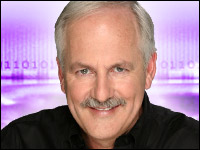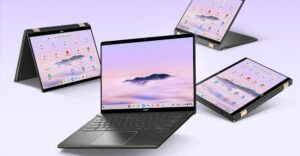
One of the things that fascinates me is how large companies, when given an “in your face” example from a competitor, more often than not ignore it.
For instance, Apple is one of the few companies that designs marketing into their products, out-executes the industry in marketing, and enjoys the highest segment margins and generally the highest growth rates, yet few seem to make the connection. Amazon and HP are two of the few companies that are taking a page directly out of Apple’s book (Palm with the Palm Pre is another) and benefiting from it.
Let’s talk about the new Kindle 2, the Apple lesson Amazon is applying to sell it, and how HP is emulating Apple and approaching the SMB market as an integrated company.
We’ll close with my product of the week, an ugly duckling notebook that, in use, is kind of swan-like.
Apple’s Magic
It was almost sad to watch Apple’s latest announcement, not because it didn’t contain great products but because the launch lacked Steve Jobs’ traditional magic. While some were arguing the Mac mini was irrelevant and many of us are anticipating the first Apple netbook, the reality is this is one of Apple’s strongest lines, and largely because the entire line uses Nvidia graphics, we can now begin to anticipate Snow Leopard, which is expected to make some big user interface (UI) graphical jumps as a result.
For Apple, their top guy, Steve Jobs, is intimate with key products from birth to launch and typically (this latest being an exception) is the person to present (pitch) these products to the world. But that’s not the only lesson in this instance. Steve Jobs runs Apple like a company, and while Apple is known for internal disputes, when it comes to market, everyone in the firm seems to be on the same page.
You don’t see the iPod or the iPhone taking away from the iMac, for instance. And there is a sense with Apple products that they do, in fact, work better together. However — and this is the second lesson I’m focused on here — they also get that their products have to work with competing platforms. If the iPod and iPhone didn’t work with Windows PCs, they would likely be a close No. 1 or No. 2 in a much smaller MP3 player market, rather than the dominant leader.
It actually amazes me how many companies seem to want to lock down their offerings and miss out on a massive amount of revenue by doing so. Let’s move to Amazon and Kindle.
The Kindle 2: Learning From the iPod
While Amazon’s Jeff Bezos is no Steve Jobs, he has husbanded the Kindle to market both times. Most recently he went on tour with the product and even showcased it on “The Daily Show With Jon Stewart.” When a CEO takes a personal interest in a product, it can make a huge difference in terms of keeping the development team focused during the product’s birth and driving excitement when it comes to market.
To date, though the Palm Pre may beat it, the Kindle is tracking very closely to the numbers the initial iPod generated as a result. I’ve been a Kindle fan since the start, personally, and have the Kindle 2. I actually use it more than any MP3 player I have because I like reading more than I like listening to music. The only downside to the new version, carried over from the last, is the lack of a light for night reading.
Like many, I love my new Kindle 2. The new Kindle 2 goes in and out of suspend almost instantly (you had to wait a long time for the first-generation unit to wake up), has much better battery life, and will sync across all your readers. This is really handy if you have two Kindles, because you remain in the same point in the book on both. It is also lighter, better looking, and much more comfortable to hold and use.
The new text-to-speech reader is surprisingly good. While a book on tape is somewhat better to listen to, you can’t currently sync a book on tape with an actual book, and you can do that across several Kindle readers now. If you use the Kindle a lot, the new one is actually worth the money. By the way, if you have a Kindle 1, you can download software update and get, for free, a number of the Kindle 2’s new features.
However, the other lesson that Amazon learned from Apple was to allow the media to move. In this case, Amazon created an iPhone reader, and a PC reader is supposedly coming. For Amazon, it is the sale of books — not the reader — that drive revenue, and Amazon appears to be wisely going down the path of letting those books move places where the Kindle isn’t.
HP Learning to Fight as a Company
The larger and more complex a company becomes, the more difficult it is for it to demonstrate synergy between its increasingly diverse parts. As mentioned above, Apple does this very well, and companies like Microsoft and Sony struggle with this concept — Sony so much that they just restructured largely to address this problem.
Last week HP launched its SMB effort, which cuts across all three major HP divisions: the Imaging and Printing Group, Personal Systems Group and Technology Solutions Group.
The result was a story that showcased more the power of HP as a company than the more traditional every-division-for-itself approach. It showcased inkjet printers that outperform and are cheaper than their laser counterparts, a business touchscreen PC, hosted services for communications fundamentals, aggressive financing and bundling options that cut across divisions, and a set of services specifically targeted at this segment.
One of the most interesting products was a 42-inch HD Monitor with an EEFL lamp (LD4200) [*Editor’s Note] for in-store messaging. At US$1,400 it would make an interesting TV monitor for a set-top box implementation or where someone wanted to set up virtual windows or a large digital picture frame.
In the end, this was the rare example of a complex corporation positioning itself against a market as a company rather than separate units and, if HP executes well, this should do nice things for it, much as a similar practice has done for Apple.
Wrapping Up
Apple sets some incredibly good examples that range from remembering where the money is and executive-driven designs that sell (like the Amazon Kindle showcases) or fighting as a company (as HP demonstrated).
While we wait for the highly anticipated Palm Pre to launch, which also appears to come from Apple lessons, I think it’s good that we remember what these lessons are and that others would do well to emulate them.
Product of the Week: The Amazing Panasonic CF-F8
This is a product I wasn’t prepared to like and fell in love with. Panasonic is known for a lot of things, but in the laptop space, they are the leader in hardened laptops. These are products that you would use if your life depended on them, and in the military, lives often do. The CF-F8 is a business hardened laptop, and that means that it’s given up some of the armor (it probably won’t stop a bullet) for a lighter weight (under 4 pounds), and it comes in with a more affordable cost and features that you or I are more likely to actually use. At around $2,800, it isn’t cheap, but consider it the Mercedes Benz of laptops, and like a Mercedes, it should hold up longer than most.
CF-F8 is more water resistant and sturdier than most business notebooks (it even has a special semi-sealed DVD drive). However — and this is kind of funny — the part that I’ve come to love is the handle. If you travel like I do, juggling your bag and laptop through security generally results in something being dropped, and the handle on the Panasonic makes the whole process much easier to complete without a problem (and if you do drop the Panasonic, you don’t have an instant coronary). It is one of the best laptops I’ve ever carried, I wasn’t expecting to like it as much as I have, and it solves a problem I have every time I travel, which is why the Panasonic CF-F8 is my product of the week.
Rob Enderle is a TechNewsWorld columnist and the principal analyst for the Enderle Group, a consultancy that focuses on personal technology products and trends.
*ECT News Network Editor’s Note: The original published version of this story described the LD4200 as an “HD LED backlit monitor,” based on erroneous information an HP rep provided to Enderle during his briefing at the SMB Launch Event.



















































